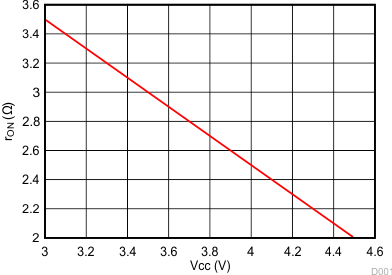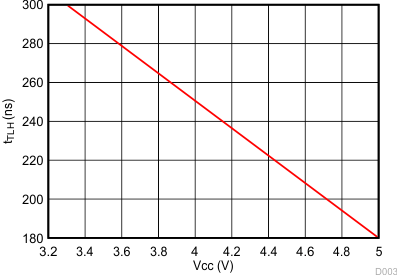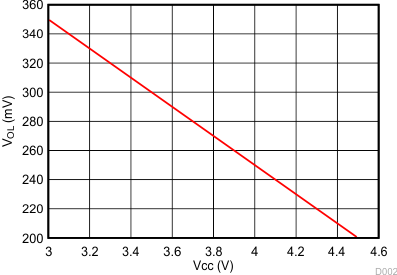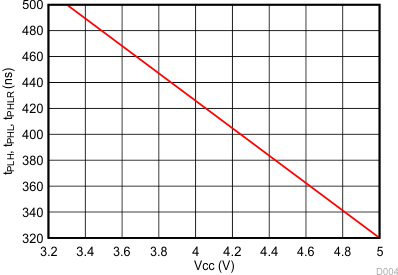SCLS711A March 2009 – November 2015 TLC59210
PRODUCTION DATA.
- 1 Features
- 2 Applications
- 3 Description
- 4 Revision History
- 5 Pin Configuration and Functions
-
6 Specifications
- 6.1 Absolute Maximum Ratings
- 6.2 ESD Ratings
- 6.3 Recommended Operating Conditions
- 6.4 Thermal Information
- 6.5 Electrical Characteristics: VCC = 4.5 V to 5.5 V
- 6.6 Electrical Characteristics: VCC = 3 V to 3.6 V
- 6.7 Timing Requirements: VCC = 4.5 V to 5.5 V
- 6.8 Timing Requirements: VCC = 3 V to 3.6 V
- 6.9 Switching Characteristics: VCC = 4.5 V to 5.5 V
- 6.10 Switching Characteristics: VCC = 3 V to 3.6 V
- 6.11 Typical Characteristics
- 7 Parameter Measurement Information
- 8 Detailed Description
- 9 Application and Implementation
- 10Power Supply Recommendations
- 11Layout
- 12Device and Documentation Support
- 13Mechanical, Packaging, and Orderable Information
パッケージ・オプション
メカニカル・データ(パッケージ|ピン)
サーマルパッド・メカニカル・データ
発注情報
6 Specifications
6.1 Absolute Maximum Ratings
(1)over operating free-air temperature range (unless otherwise noted)| MIN | MAX | UNIT | ||||
|---|---|---|---|---|---|---|
| VCC | Supply voltage | –0.5 | 7 | V | ||
| D | Input voltage | –0.5 | 7 | V | ||
| Vds | Output voltage | H output | –0.5 | 32 | V | |
| Ids | Output current | 1 bit for output low, | VCC = 3 V to 3.6 V | 100 | mA | |
| VCC = 4.5 V to 5.5 V | 200 | |||||
| IIK | Input clamp current | VI < 0 V | –20 | mA | ||
| Operating free-air temperature | –40 | 85 | °C | |||
| Tstg | Storage temperature | –65 | 150 | °C | ||
(1) Stresses beyond those listed under "absolute maximum ratings" may cause permanent damage to the device. These are stress ratings only, and functional operation of the device at these or any other conditions beyond those indicated under "recommended operating conditions" is not implied. Exposure to absolute-maximum-rated conditions for extended periods may affect device reliability.
6.2 ESD Ratings
| VALUE | UNIT | |||
|---|---|---|---|---|
| V(ESD) | Electrostatic discharge | Human body model (HBM), per ANSI/ESDA/JEDEC JS-001(1) | ±2000 | V |
| Charged-device model (CDM), per JEDEC specification JESD22-C101(2) | ±1000 | |||
| Machine Model (A115-A), per ANSI/ESDA/JEDEC Standard JESD-17(3) | ±200 | |||
(1) JEDEC document JEP155 states that 500-V HBM allows safe manufacturing with a standard ESD control process.
(2) JEDEC document JEP157 states that 250-V CDM allows safe manufacturing with a standard ESD control process.
(3) JEDEC document JEP157 states that 200-V MM allows safe manufacturing with a standard ESD control process.
6.3 Recommended Operating Conditions
| MIN | MAX | UNIT | ||||
|---|---|---|---|---|---|---|
| VCC | Supply voltage | 3 | 5.5 | V | ||
| VIH | High-level input voltage | VCC × 0.7 | VCC | V | ||
| VIL | Low-level input voltage | 0 | VCC × 0.3 | V | ||
| Vds | Output voltage | 30 | V | |||
| Ids | Output current | N package, VCC = 4.5 V to 5.5 V |
Duty cycle < 42% | 200 | mA | |
| Duty cycle < 100% | 130 | |||||
| PW package, VCC = 4.5 V to 5.5 V |
Duty cycle < 24% | 200 | ||||
| Duty cycle < 100% | 95 | |||||
| TA | Operating free-air temperature | –40 | 85 | °C | ||
6.4 Thermal Information
| THERMAL METRIC(1) | TLC59210 | UNIT | ||
|---|---|---|---|---|
| N (PDIP) | PW (TSSOP) | |||
| 20 PINS | 20 PINS | |||
| RθJA | Junction-to-ambient thermal resistance | 53.6 | 94.3 | °C/W |
| RθJC(top) | Junction-to-case (top) thermal resistance | 41.2 | 28.3 | °C/W |
| RθJB | Junction-to-board thermal resistance | 34.6 | 45.7 | °C/W |
| ψJT | Junction-to-top characterization parameter | 22.3 | 1.6 | °C/W |
| ψJB | Junction-to-board characterization parameter | 34.4 | 45.1 | °C/W |
| RθJC(bot) | Junction-to-case (bottom) thermal resistance | N/A | N/A | °C/W |
(1) For more information about traditional and new thermal metrics, see the Semiconductor and IC Package Thermal Metrics application report, SPRA953.
6.5 Electrical Characteristics: VCC = 4.5 V to 5.5 V
over recommended operating free-air temperature range, TA = –40°C to 85°C (unless otherwise noted)| PARAMETER | TEST CONDITIONS | MIN | TYP | MAX | UNIT | ||
|---|---|---|---|---|---|---|---|
| VT+ | Positive-going input threshold | D, CLR, CLK | 3.5 | V | |||
| VT– | Negative-going input threshold | D, CLR, CLK | 1.5 | V | |||
| VHYS | Hysteresis | D, CLR, CLK | 0.5 | 2 | V | ||
| IIH | High-level input current | VCC = 5.5 V, VI = 5.5 V | 0 | 1 | μA | ||
| IIL | Low-level input current | VCC = 5.5 V, VI = 0 V | 0 | –1 | μA | ||
| IOZ | Leakage current | Vds= 30 V | 5 | μA | |||
| Ioff | Leakage current | VI = 0 to 5 V, VO = 0 to 30 V, VCC = 0 | 0 | 5 | μA | ||
| ICC | Supply current | VI = 0 to 5 V, VO = 0 to 30 V, VCC = 0 | Output = all OFF | 0 | 5 | μA | |
| Output = all ON | 0 | 5 | |||||
| VOL | Low-level output voltage | VCC = 4.5 V, IO = 100 mA | 0.2 | 0.35 | V | ||
| VCC = 4.5 V, IO = 200 mA | 0.5 | 0.7 | V | ||||
| rON | ON-state resistance | VCC = 4.5 V, IO = 100 mA | 2 | 3.5 | Ω | ||
| Ci | Input capacitance | VI = VCC or GND | 5 | pF | |||
6.6 Electrical Characteristics: VCC = 3 V to 3.6 V
over recommended operating free-air temperature range, TA = –40°C to 85°C (unless otherwise noted)| PARAMETER | TEST CONDITIONS | MIN | TYP | MAX | UNIT | ||
|---|---|---|---|---|---|---|---|
| VT+ | Positive-going input threshold | D, CLR, CLK | 2.52 | V | |||
| VT– | Negative-going input threshold | D, CLR, CLK | 0.9 | V | |||
| VHYS | Hysteresis | D, CLR, CLK | 0.33 | 1.32 | V | ||
| IIH | High-level input current | VCC = 3.6 V, VI = 3.6 V | 0 | 1 | μA | ||
| IIL | Low-level input current | VCC = 3.6 V, VI = 0 V | 0 | –1 | μA | ||
| IOZ | Leakage current | VO= 30 V | 5 | μA | |||
| Ioff | Leakage current | VCC = 0 V, VI = 0 to 3.6 V, VO = 0 to 30 V | 0 | 5 | μA | ||
| ICC | Supply current | VCC = 3.6 V, VI = 0 to 3.6 V, VO = 0 to 30 V | Output = all OFF | 0 | 5 | μA | |
| Output = all ON | 0 | 5 | |||||
| VOL | Low-level output voltage | VCC = 3 V, IO = 100 mA | 0.35 | 0.7 | V | ||
| rON | ON-state resistance | VCC = 3 V, IO = 100 mA | 3.5 | 7 | Ω | ||
| Ci | Input capacitance | VI = VCC or GND | 5 | pF | |||
6.7 Timing Requirements: VCC = 4.5 V to 5.5 V
over recommended operating free-air temperature range, O/C to Y (unless otherwise noted)| MIN | NOM | MAX | UNIT | |||
|---|---|---|---|---|---|---|
| tsu | Setup time, CLK↑ | VDD = 4.5 V | 10 | ns | ||
| th | Hold time, CLK↑ | VDD = 4.5 V | 10 | ns | ||
| tw | Pulse width, CLK, CLR | VDD = 4.5 V | 30 | ns | ||
6.8 Timing Requirements: VCC = 3 V to 3.6 V
over recommended operating free-air temperature range, O/C to Y (unless otherwise noted)| MIN | NOM | MAX | UNIT | |||||
|---|---|---|---|---|---|---|---|---|
| tsu | Setup time, CLK↑ | VDD = 3 V | 10 | ns | ||||
| th | Hold time, CLK↑ | VDD = 3 V | 10 | ns | ||||
| tw | Pulse width, CLK, CLR | VDD = 3 V | 30 | ns | ||||
6.9 Switching Characteristics: VCC = 4.5 V to 5.5 V
over recommended operating free-air temperature range, TA = –40°C to 85°C (unless otherwise noted), see Figure 5| PARAMETER | TEST CONDITIONS | LOAD CAPACITANCE | MIN | TYP | MAX | UNIT | |
|---|---|---|---|---|---|---|---|
| tTLH | Output = low to high | TA = 25°C | CL = 30 pF, RL = 240 Ω, 24-V pullup |
180 | 230 | ns | |
| TA = –40°C to 85°C | 260 | ||||||
| tTHL | Output = high to low | TA = 25°C | CL = 30 pF, RL = 240 Ω, 24-V pullup |
300 | 450 | ns | |
| TA = –40°C to 85°C | 500 | ||||||
| tPLH | Output = low to high | TA = 25°C | CL = 30 pF, RL = 240 Ω, 24-V pullup |
320 | 480 | ns | |
| TA = –40°C to 85°C | 550 | ||||||
| tPHL | Output = high to low | TA = 25°C | CL = 30 pF, RL = 240 Ω, 24-V pullup |
320 | 480 | ns | |
| TA = –40°C to 85°C | 550 | ||||||
| tPHLR | CLR–Y | TA = 25°C | CL = 30 pF, RL = 240 Ω, 24-V pullup |
320 | 480 | ns | |
| TA = –40°C to 85°C | 550 | ||||||
6.10 Switching Characteristics: VCC = 3 V to 3.6 V
over recommended operating free-air temperature range, TA = –40°C to 85°C (unless otherwise noted), see Figure 5| PARAMETER | TEST CONDITIONS | LOAD CAPACITANCE | MIN | TYP | MAX | UNIT | |
|---|---|---|---|---|---|---|---|
| tTLH | Output = low to high | TA = 25°C | CL = 30 pF, RL = 240 Ω, 24-V pullup |
300 | 450 | ns | |
| T A= –40°C to 85°C | 500 | ||||||
| tTHL | Output = high to low | TA = 25°C | CL = 30 pF, RL = 240 Ω, 24-V pullup |
300 | 450 | ns | |
| T A= –40°C to 85°C | 500 | ||||||
| tPLH | Output = low to high | TA = 25°C | CL = 30 pF, RL = 240 Ω, 24-V pullup |
500 | 700 | ns | |
| T A= –40°C to 85°C | 850 | ||||||
| tPHL | Output = high to low | TA = 25°C | CL = 30 pF, RL = 240 Ω, 24-V pullup |
500 | 700 | ns | |
| T A= –40°C to 85°C | 850 | ||||||
| tPHLR | CLR–Y | TA = 25°C | CL = 30 pF, RL = 240 Ω, 24-V pullup |
500 | 700 | ns | |
| T A= –40°C to 85°C | 850 | ||||||
6.11 Typical Characteristics

| IO = 100mA | ||

| CL = 30 pF | RL = 240 Ω, 24-V Pullup | |

| IO = 100mA | ||

| CL = 30 pF | RL = 240 Ω, 24-V Pullup | |